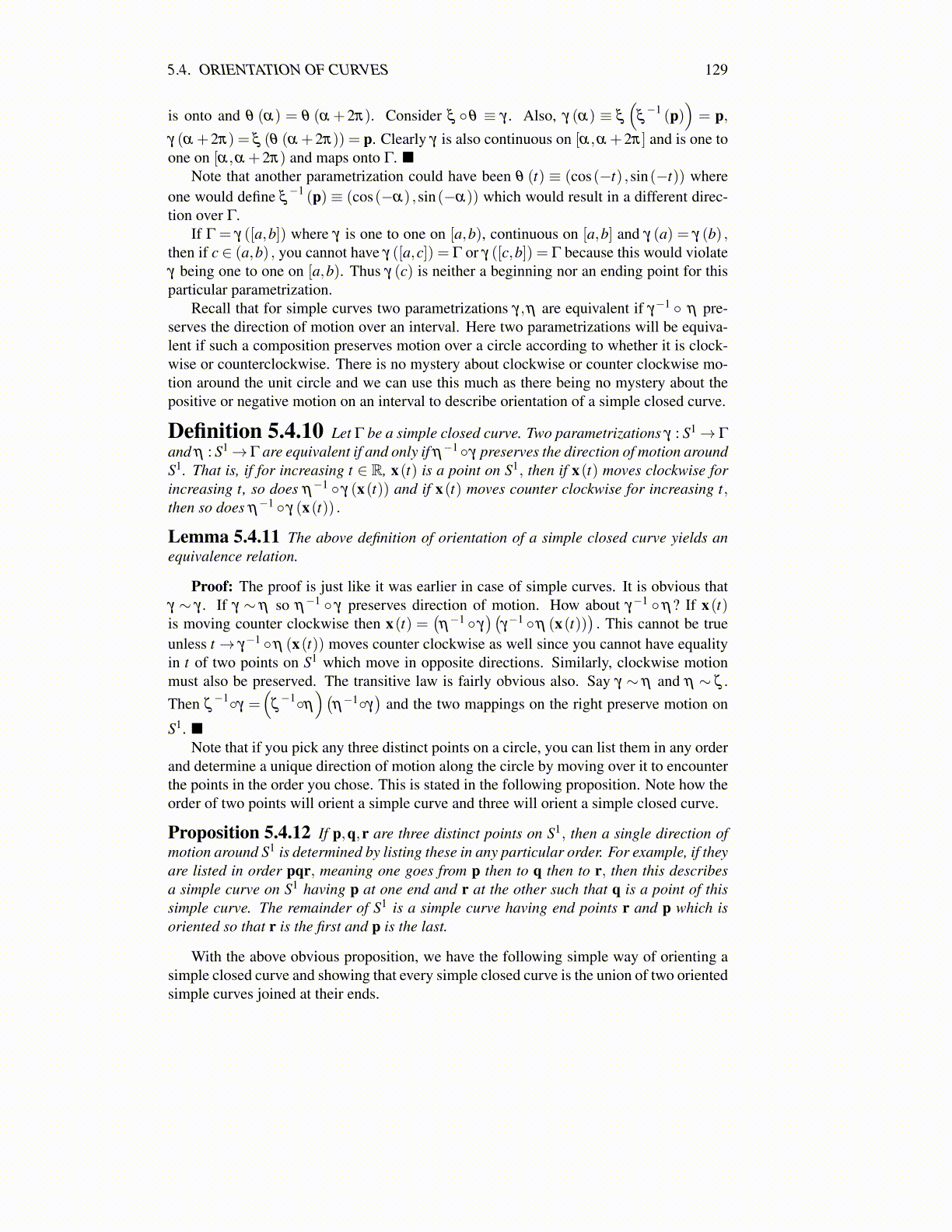
5.4. ORIENTATION OF CURVES 129
is onto and θ (α) = θ (α +2π). Consider ξ ◦θ ≡ γ . Also, γ (α) ≡ ξ
(ξ−1 (p)
)= p,
γ (α +2π) = ξ (θ (α +2π)) = p. Clearly γ is also continuous on [α,α +2π] and is one toone on [α,α +2π) and maps onto Γ. ■
Note that another parametrization could have been θ (t) ≡ (cos(−t) ,sin(−t)) whereone would define ξ
−1 (p) ≡ (cos(−α) ,sin(−α)) which would result in a different direc-tion over Γ.
If Γ = γ ([a,b]) where γ is one to one on [a,b), continuous on [a,b] and γ (a) = γ (b) ,then if c ∈ (a,b) , you cannot have γ ([a,c]) = Γ or γ ([c,b]) = Γ because this would violateγ being one to one on [a,b). Thus γ (c) is neither a beginning nor an ending point for thisparticular parametrization.
Recall that for simple curves two parametrizations γ,η are equivalent if γ−1 ◦ η pre-serves the direction of motion over an interval. Here two parametrizations will be equiva-lent if such a composition preserves motion over a circle according to whether it is clock-wise or counterclockwise. There is no mystery about clockwise or counter clockwise mo-tion around the unit circle and we can use this much as there being no mystery about thepositive or negative motion on an interval to describe orientation of a simple closed curve.
Definition 5.4.10 Let Γ be a simple closed curve. Two parametrizations γ : S1→ Γ
and η : S1→Γ are equivalent if and only if η−1◦γ preserves the direction of motion aroundS1. That is, if for increasing t ∈ R, x(t) is a point on S1, then if x(t) moves clockwise forincreasing t, so does η−1 ◦ γ (x(t)) and if x(t) moves counter clockwise for increasing t,then so does η−1 ◦ γ (x(t)) .
Lemma 5.4.11 The above definition of orientation of a simple closed curve yields anequivalence relation.
Proof: The proof is just like it was earlier in case of simple curves. It is obvious thatγ ∼ γ . If γ ∼ η so η−1 ◦ γ preserves direction of motion. How about γ−1 ◦ η? If x(t)is moving counter clockwise then x(t) =
(η−1 ◦ γ
)(γ−1 ◦η (x(t))
). This cannot be true
unless t→ γ−1 ◦η (x(t)) moves counter clockwise as well since you cannot have equalityin t of two points on S1 which move in opposite directions. Similarly, clockwise motionmust also be preserved. The transitive law is fairly obvious also. Say γ ∼ η and η ∼ ζ .Then ζ
−1◦γ =(
ζ−1◦η
)(η−1◦γ
)and the two mappings on the right preserve motion on
S1. ■Note that if you pick any three distinct points on a circle, you can list them in any order
and determine a unique direction of motion along the circle by moving over it to encounterthe points in the order you chose. This is stated in the following proposition. Note how theorder of two points will orient a simple curve and three will orient a simple closed curve.
Proposition 5.4.12 If p,q,r are three distinct points on S1, then a single direction ofmotion around S1 is determined by listing these in any particular order. For example, if theyare listed in order pqr, meaning one goes from p then to q then to r, then this describesa simple curve on S1 having p at one end and r at the other such that q is a point of thissimple curve. The remainder of S1 is a simple curve having end points r and p which isoriented so that r is the first and p is the last.
With the above obvious proposition, we have the following simple way of orienting asimple closed curve and showing that every simple closed curve is the union of two orientedsimple curves joined at their ends.